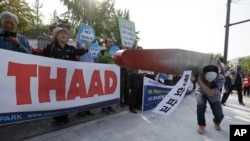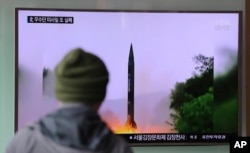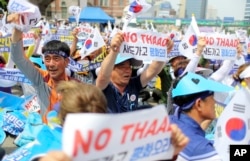U.S. Secretary of Defense Ash Carter on Thursday "strongly condemned" the failed ballistic missile launch that occurred in North Korea earlier in the day.
The North American Aerospace Defense Command said North Korea had most likely launched a Musudan intermediate-range missile near the northwestern city of Kusong. U.S. and South Korean monitors said the missile exploded shortly after takeoff and thus posed no threat.
Speaking with South Korean Defense Minister Han Min-koo at a joint news conference at the Pentagon, Carter said he and Han had discussed options for extended deterrence against the North Korean nuclear threat.
The U.S. Strategic Command and South Korea's Office of the Joint Chiefs of Staff said North Korea's latest launch attempt seemed to replicate a failed test that occurred Saturday, in that it involved the same type of missile and the same location.
South Korea and Japan immediately condemned Thursday’s test.
Japan's chief cabinet secretary, Yoshihide Suga, said Tokyo, "through diplomatic routes via the embassy in Beijing, has officially protested this and condemns this launch." He also said Japan expected more missiles out of North Korea as the country expands its development program.
Earlier this week, the U.N. Security Council issued a strong condemnation of Saturday’s launch attempt by the North, saying it was "a clear violation" of UNSC resolutions and an "illegal act of provocation."
The Kim Jong Un government has responded defiantly to tough U.N. sanctions imposed on North Korea in March by conducting numerous missile launches and a second nuclear test in one year.
North Korea has launched eight Musudan missiles in all this year. One, launched June 22, flew 400 kilometers into the Sea of Japan and reached an altitude of more than 1,400 kilometers. The others exploded shortly after takeoff. Analysts say, however, that each test is helping North Korea advance its capabilities and reach its goal of developing a credible nuclear ballistic missile arsenal that could potentially strike the U.S. mainland.
Extended deterrence
The U.S., at its bases in South Korea, is considering the permanent deployment of B-1B and nuclear-capable B-52 bombers, F-22 stealth fighter jets and nuclear-powered submarines to try to deter the North Korean nuclear threat, according to defense and diplomatic sources.
Wednesday’s establishment of a high-level Extended Deterrence Strategy and Consultation Group was accompanied by unusually blunt public comments from the U.S. secretaries of defense and state about the possibility of nuclear war initiated by Pyongyang on the Korean Peninsula.
“Any use of nuclear weapons will be met with an overwhelming and effective response,” Carter said ahead of 2+2 security talks with the South Korean defense and foreign ministers.
South Korea’s security is guaranteed by the “full spectrum of U.S. defense capabilities,” Carter said in a reference to the American nuclear defense shield protecting the U.S. ally.
‘Dagger against our throats’
Hours later, U.S. Secretary of State John Kerry, at a news conference standing alongside Japanese Minister of Foreign Affairs Yun Byung-se, repeated the same stark rhetoric and predicted “North Korea will never attain its goals through threats and intimidation."
Yun, at the start of the talks, said Pyongyang is nearing the "final stage of nuclear weaponization," compelling the United States and South Korea to utilize "all tools in the tool kit" to defend themselves and make the North Koreans “feel the panic under their skins."
Han said North Korea’s nuclear weapons and missiles were akin to "a dagger against our throats."
THAAD deployment
While continuing to work for denuclearization, “we need to ensure working together that the DPRK pays a price for its dangerous actions,” said Kerry.
Amid what he termed a “pivotal moment” on the Korean Peninsula, Kerry added that the United States would deploy to South Korea “as soon as possible” a Terminal High-Altitude Area Defense (THAAD) battery.
China and some in South Korea oppose the deployment of the anti-ballistic missile system, contending it unnecessarily exacerbates tensions in the region.
Kerry maintained that the military option to stop North Korea’s ongoing nuclear weapons and ballistic missile programs was “a last resort.”
Analysts’ reactions
Wednesday’s tougher language from top U.S. officials caught some by surprise, but was most likely welcomed by hawks who argue that diplomacy and economic sanctions have failed to deter Pyongyang.
“I don’t think this stronger rhetoric is going to deter them from taking the next step, whatever their next is,” said CSIS-Pacific Forum adjunct fellow Tara O, the author of “The Collapse of North Korea: Challenges, Planning and Geopolitics of Unification.”
Other analysts question the potential basing of U.S. Air Force bombers to American bases in South Korea.
"I don't see why you need B-52s and B-1s on the peninsula. That puts them within DPRK short-range missiles, and therefore more vulnerable than if they remain at Andersen [Air Force Base on Guam].
"They can fly to Korea in a few hours," said Troy University international relations professor Daniel Pinkston, author of "The North Korean Ballistic Missile Program."
Basing such aircraft and THAAD on the Korean Peninsula, he said, would cause China "to be in an uproar" and officials in Pyongyang and Beijing to assert that such forward-deployed assets are really intended to deter the Chinese.
Carter’s stark reference Wednesday to nuclear retaliation will raise questions about “are we seriously going to use” the nuclear option, said the retired U.S. Air Force lieutenant colonel who did three tours of duty on the Korean Peninsula and also specialized in regional security matters at the Pentagon.
“Someone has to make a decision on what will be an acceptable cost if we are to carry out anything beyond rhetoric,” Pinkston told VOA.
The two Koreas have no diplomatic ties and have technically remained at war since a devastating three-year conflict in the early 1950s ended in stalemate. The Korean War drew in Chinese forces supporting the North, while a U.S.-led U.N. coalition countered the North's invasion of the South.
VOA correspondents Carla Babb in Washington and Brian Padden in Seoul contributed to this report.












